LATITUDE 69
23 February - April 2024
Warning : I'm not finished writing this page lol
Summary
From a dumb joke to the hardest and epicest adventure of my life. Following the 69th latitude line as far west as possible from where I crossed it this summer on my cycling trip to the north, in winter. It ended up a 440km long adventure mixing skiing in -20°C with a 70kg pulk, packrafting on the fjords and walking on the roads.
Map & links
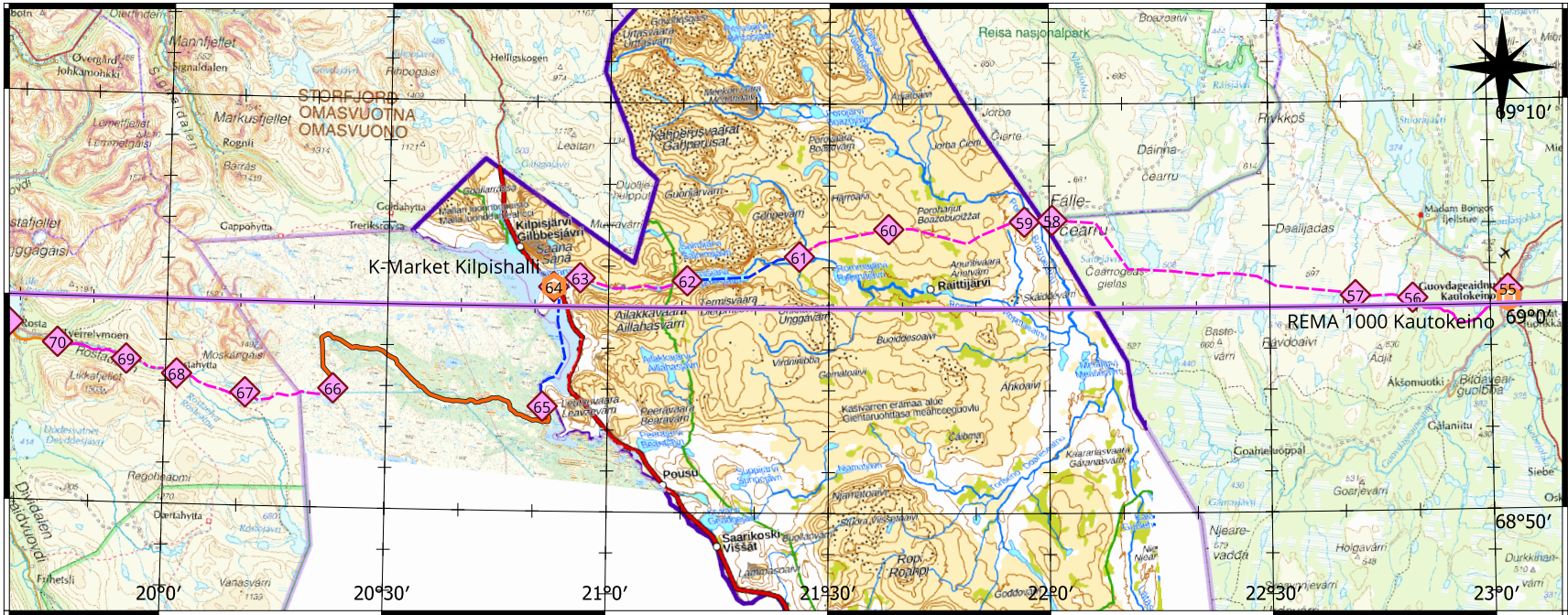


Summary
Context & motivation
After reaching the north cape in october and seeing those huge empty spaces getting their first snow, I couldn't get the idea of going skiing there, at least for a few weeks, out of my head. I would not have the opportunity to do it for the next 3 winters because of studies, so I had to take my chance and do something. Following a latitude like Mike Horn did on his "Latitude 0" and "Arktos" expeditions was something I wanted to try for a long time, and I liked the silliness of following through with a stupid but pretty funny idea like the 69th.
Planning & preparation
The plan went trough a lot of phases. I was not trying to plan a cool pulka tour, but more like searching for a way to go as west from Kautokeino as possible. A lot of uncertainties and doubts came from the fact that I did not knew for sure I would be able to find said way, let alone actually pass it. I had never used a pulk before, nor been exposed to the harsher winter environnement above the arctic circle.
It was pretty much a planning nightmare. I had to limit the costs of the gear as much as possible because I was short on money, and at the same time, I was still analyzing maps and satellite images searching for ways to get where I wanted. There is multiple interpretations for "following the 69th parallel". Should I stay as close as possible from the line but stay above it? How far should I be allowed to stray from it ? This might seem like silly details, but when in the realm of silly adventures, silly geographical details are important.
The packrafting idea really was the cherry on top. Completely unreasonable, but impossible to get out of my head. I was convinced it was somehow possible, inspired by Mike Horn and Borge Ousland packrafting across cracks in the ice during their North Pole expedition. I decided to just stay as close as possible to the line, above or under it, because that was the only way to reach its very end at Nyksund, just before the Atlantic ocean. But that would require 5 packraft crossing and all the troubles that goes with it : How to stay dry ? Will the pulka float ? Can my packraft even resist to the cold temperatures I would be exposing him to ? He was absolutely never designed for such extreme uses.
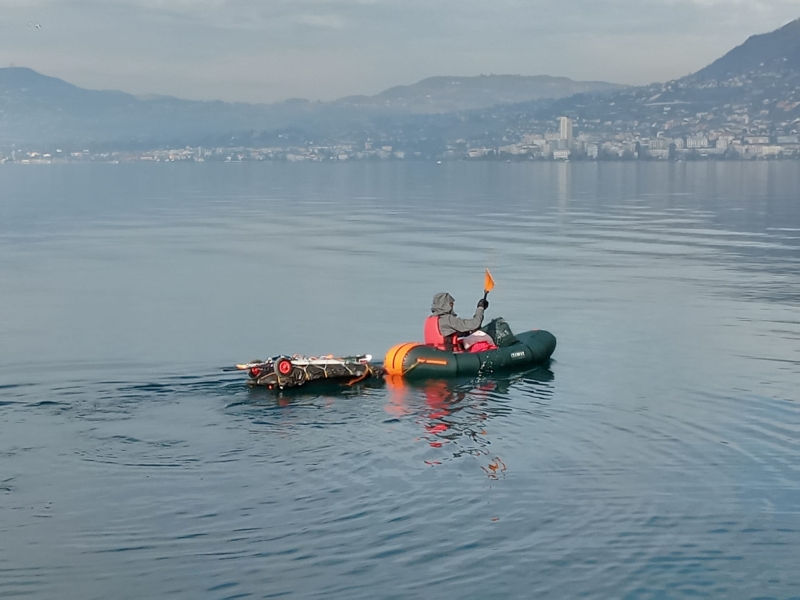
The first successful packraft test
Add to this mess a sprained thumb and a knee tendonitis in the month preceding my theoretical departure date and you have a pretty good picture of why I couldn't really train very much at all. I focused on finding solutions to the camping problems, buying the right gear, crafting good systems for pulk loading, cooking, sleeping, etc. The fact that it had to be switchable between snow, road and water added a bit of difficulty to that. I ended up mounting the front wheel system, absolutely essential for the roads, only 3 days before leaving. And printing the maps (made with QGIS) the night before around midnight.
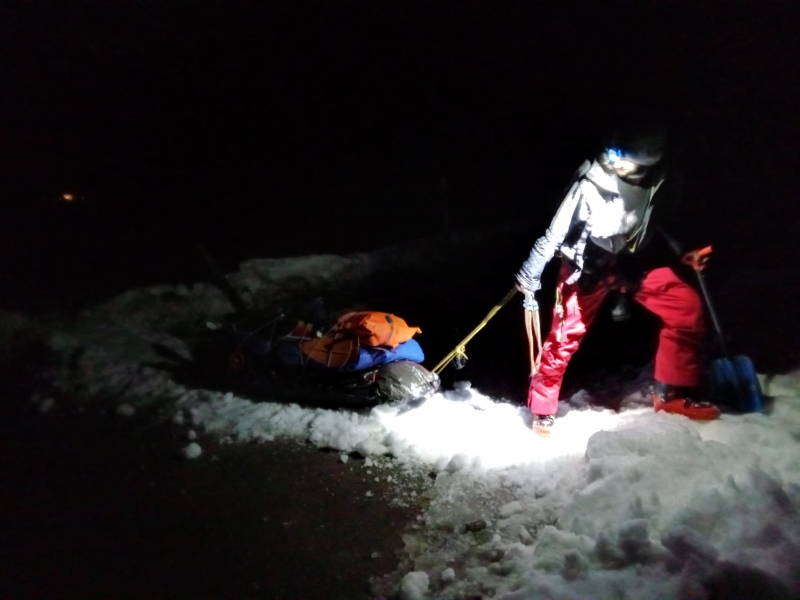
Crossing a road late at night during training
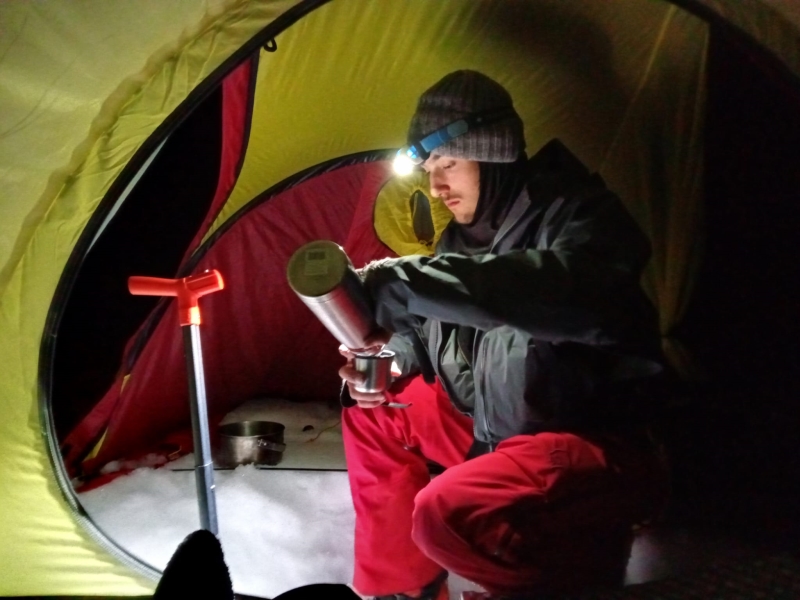
And enjoying the brand new and pretty expensive Helsport tent :)
Getting to the start
For ecological and adventure purposes, I didn't want to take any plane. I took an interrail pass and left home on the 18th february, for what was supposed to be a 3 days trip. It was pretty hard to get the pulk into the first night train from Hamburg to Stockholm. The second one to Narvik was better and the view absolutely EPIC. Then I had to take a few busses in Norway to go around the empty plains I would be skiing into very soon. I would arrive somewhere very late in the evening, haul the pulk to a cool place and camp for the night before taking the next bus in the morning. Most of the roads were covered in ice, so loading and unloading from the busses was easy, no annoying wheels needed.

Night at Alta during at the end of my travel
I bought fuel supplies and a few other last minute gear items in Alta. The big departure was approaching. One bus later, I was arrived in Kautokeino and settled my tent next to the last supermarket. In the morning, I calculated how much food I would need on a base of 5500-6000 kcal per day, with a bit of margin. I had never hauled the pulk for more than 2-3 hours, and never with the added weight of the food. Shopping and charging all the batteries fully took most of my day. Loading a huge 15kg drybag inside the pulk was pretty epic. Time to go.
Day 1-11: Kautokeino - Kilpisjärvi
Near Kautokeino the snow conditions were shit. Above 50cm of powder, a crust too thin to walk on but thick enough to trap the pulk and make it near impossible to progress. I had to adapt and follow a road going north west, hoping the crust would strengthen above the treeline and I would be able to join my original planned route further up. I only walked one or two hours the first day, just after the shopping. Wandering off like that into the unknown, with 10 days of autonomy, felt pretty amazing. I didn't know whether or not I would be able to reach Kilpisjärvi, but I could always turn back after 5 days if I was really too far.
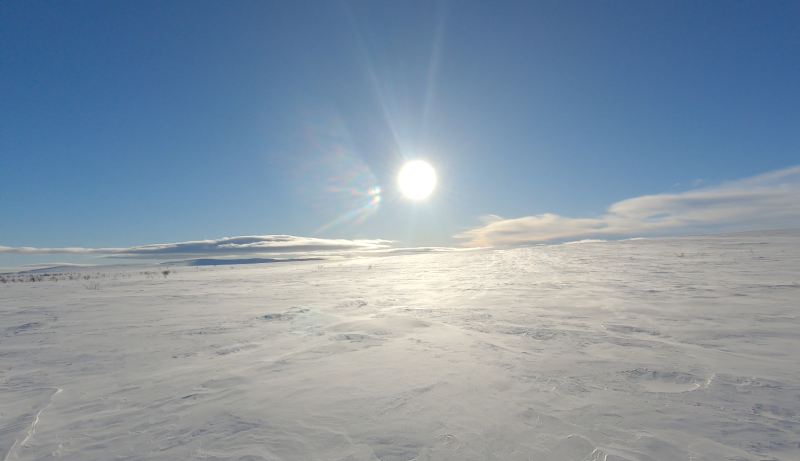
Above the treeline (~500m), the crust was thicker.
Physically, it was pretty intense. On the second day already, there was a ton of wind from the south, so always blowing sideways. Thankfully, the temperature was pretty warm around -2, -5°C. The road was super slippery and it was sometimes hard to control the pulk pushed by the wind. I eventually reached the end of the road, and it was time to face the wild snow. The start was honestly pretty awful and making progress was ridiculously slow, but sometimes, I would get a few steps without breaking the crust. It got my hope back up: the wind was indeed hardening the surface, and I supposed that the higher I would go, the harder the snow would be.
On the third day, the snow was more decent. I passed through a herd of reindeers on top of a hilly pass. I did my best to stay away and appear inoffensive, but some still got scared. It got me the friendly scolding of their herder, who came to me soon after on his snowmobile. Hauling was hard. After 4 hours and 8 kilometers, it was time to call it a day and mount my super palace, the Helsport Fjellheimen tent.
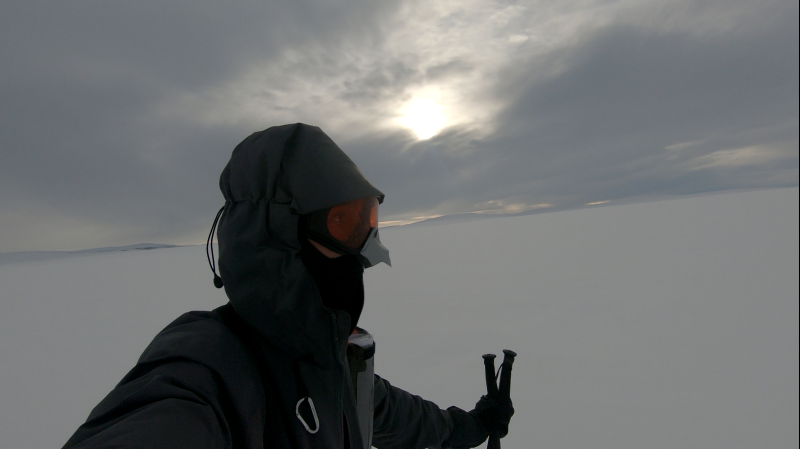
into the nothingness
4th day. I haul, haul and keep hauling this heavy pulk above each bump and feature of the snow. I kinda wonder why I am doing this, and have to keep reminding myself the end goals.
5th day. Extract of my journal:
The white space between two realms. An endless progression into the nothingness, under the all seeing eye of the sun. Like a loading screen to access the next level. The black branches popping out of the snow seemed forever lost, floating on the ocean of snow. I felt like exploring the realm of death. Until life's horns broke through the fog through the form of a very much alive reindeer :)
On the 6th day, I crossed the Poroeno river. I had no idea if it would be well frozen and crossable at the spot I chose, but my worries were unnecessary. The winter had been very cold until recently, and I couldn't even see a single true opening in the ice. In addition to this relief, I was gifted with the Tenomuotka hut, a free open cabin. I could appreciate the comfort of basic things that I had somehow forgotten already, like a table and a warm, dry interior.

Cozy inside the hut
Back to the real world, I had a great day which ended up in an epic whiteout, the kind of which you have to navigate relying only on the map and compass for direction and GPS for appreciated additional help. At some point I passed by a huge reindeer trapping fence, making a sort of spiral. I think since the metal is magnetized as a whole, it emitted a strong enough field to deviate my compass on maybe a whole kilometer.
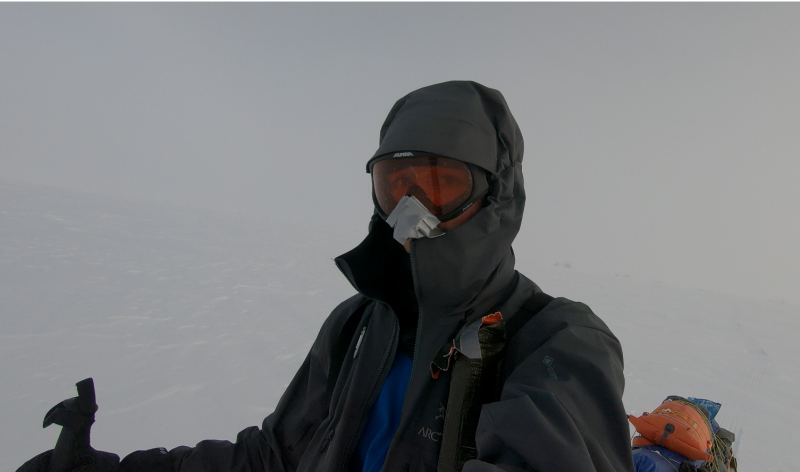
The return of the whiteout
The next day, the 8th, I came down from the hills to the valley, seeing trees again and getting closer to the snowmobile road that would get me to Kilpisjärvi, and mark the end of the wild part of this section. I was scared it would be extremely hard to pass though the thicker vegetation, but it ended up only mildly hard. There were sometimes "pow holes", little spots above or next to rocks were me and the pulk would suddenly sink 50 cm in the snow and the pulk could get stuck on trees. The snowmobile track was long and still pretty physical, but it was more of a constant, brain off keep pulling kind of effort.

Finally arrived to the snowmobile road
After another night in a luxurious (compared to the tent) hut, and a few hours of hard effort, we were right next to a frozen lake above the town, with network connection and "a lot" of humans nearby (mostly tourists on snowmobiles)
The resupply went pretty well, except I bought 1 liter of gas too much (I didn't knew it was too much yet), and forgot toilet paper. But I was already glad to be there and to have reached my first objective.
Days 12-20 : Kilpisjärvi - Overbygd
I passed one night on the lake, with beautiful northern lights and scary ice creaking sounds. The weather passed from cloudy and "warm" (-2 to -5) to full blue sky and colder temperatures during the evening and night, around -20°C. Crossing the lake went pretty well, and I soon arrived at the start of the 30km snowmobile road ascending towards a mountain pass, that I would follow for the next few days.
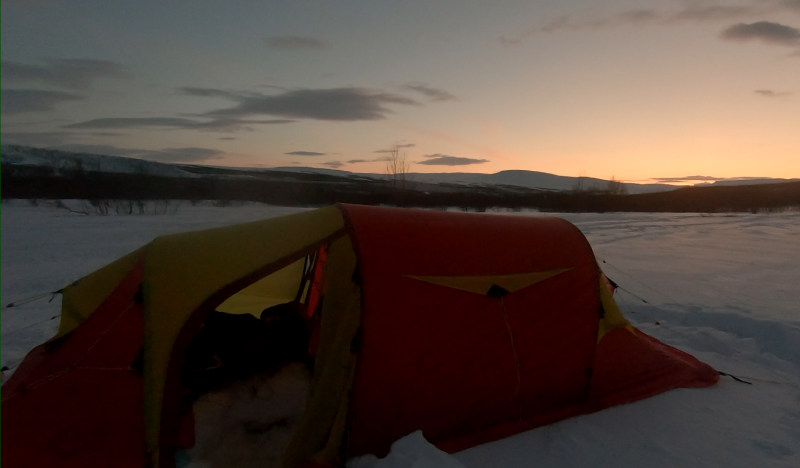
Near the lake
It was way more peaceful than the last one, and I only crossed a few snowmobilers a day. The views were great and the effort was very straight-forward. Some steep sections required me to remove the skis and plant my boots in the snow to progress, leaning forward to align the weight of the pulk with my legs. I listened to an audiobook on my mp3 to distract myself from my own hardships, and a pretty in theme one : The mountains of madness by H.P. Lovecraft, where the characters lead a scientific expedition in Antarctica.
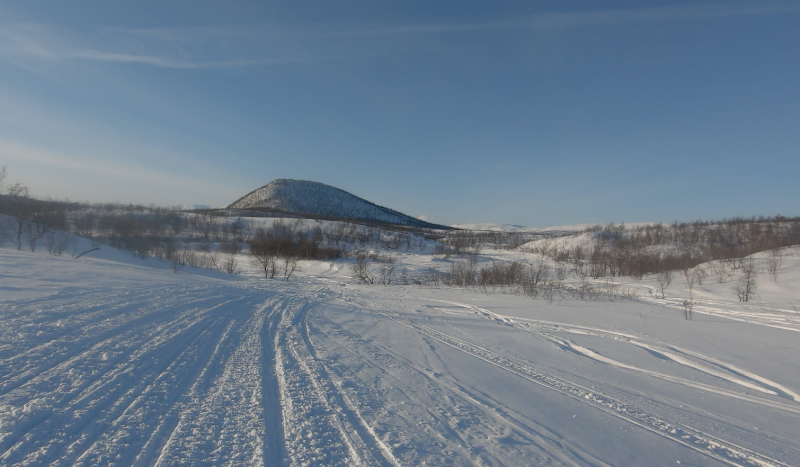
The long snowmobile road
After a lof of sweat, I was back on wild snow. I was greeted with another epic whiteout, this time slightly descending, so pretty thrilling by moments. But the next day was less fun, as I had to cross the PULKA HELL.
Basically, the valley I was in was getting steeper, and due to the lower altitude, the forest was already quite thick. I knew that, but I also knew that there was a trail passing through the forest, and I thought that it would make a big difference. Well it helped, but the snow was still pretty steep, and taking on steep slopes sideways with my pulk setup was a nightmare. The little layer of slippery fresh snow on top of everything certainly didn't help. Basically the pulk was constantly sliding down the slope, rolling over, getting stuck on every tree it could find. Instantly starting to go down the slope again as soon as I roll it back up or detach it from the trees. On top of that the zipper of my Gore-tex jacket would not close anymore, sentencing me to being super cold.
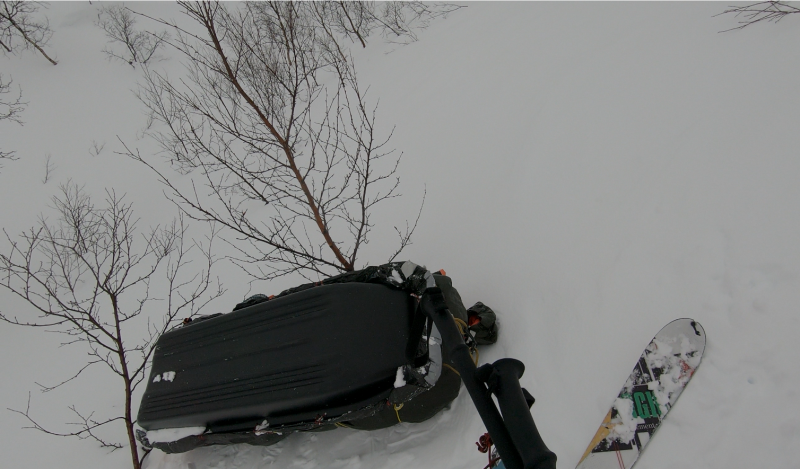
Flipped over 65kg pulk. Joy.
I still managed to pass through in 2 or 3 hours of heinous effort, but it was easily the second worst part of the whole trip I think. I then passed over a cool river and was overjoyed when I found a normal road full of normal snow for the rest of the descent. But during the next, night, my down-filled inflatable mattress completely blew up with a good 40cm tear, when I turned myself on my elbow in the middle of the night. Hopeful at first, I had to accept that it was absolutely unrepairable. Thankfully, I had a few foam mattresses and clothes I could use to isolate myself from the snow.
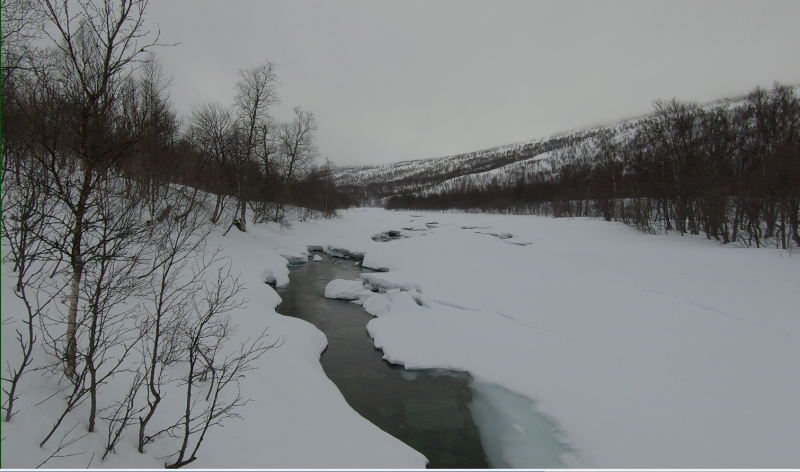
The cool river crossing
The next environnement I would have to master would be the frozen river. I was pretty impressed and hyped about the strength of the ice. Most of the time, the ice is buried under a pretty thick layer of snow, but sometimes on the sides or around some special features, I could see the actual thickness of the ice, most often super mega good enough.
After this introduction to the river world, I had to cross "Lille Roastavatn", another pretty big lake. The surface of this one had been damaged by the rain and was covered by small puddles of water, some starting to ice again already but never strong enough. I kind of regretted taking my mountains skis, because my skins were getting drenched and scratched against the ice, damaging them but more importantly making them super heavy to walk with.
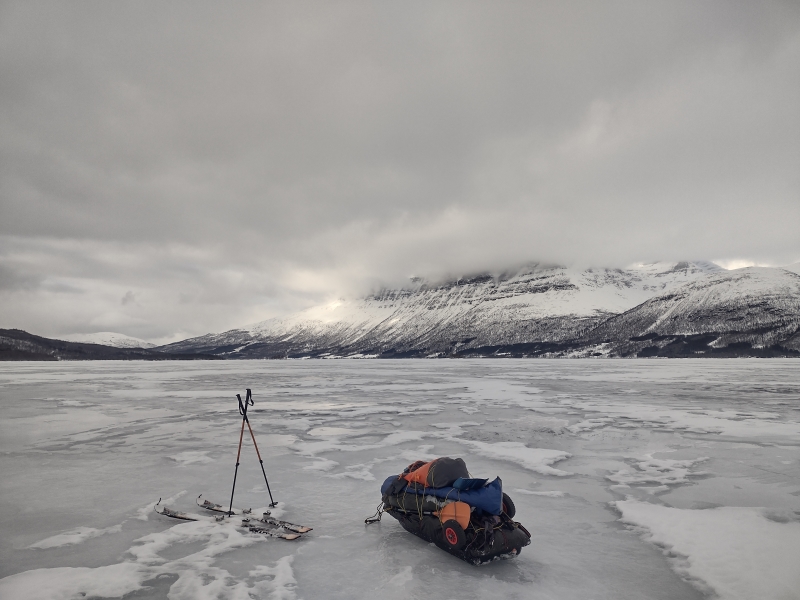
On Roastavatn
In the lake, the water warmed up thanks to the ground (probably), so the river flowing out wasn't frozen at all. It was an occasion for me to test walking on the roads with the wheels, which proved pretty efficient except for the fact that I had to walk with my ski boots. But very soon, I was in Overbygd! Shopping and choosing the right amount of food was getting easier, and I could buy one more foam mattress to add a bit of insulation to my sleep system.
Days 21-25 : Overbygd - Bardufoss
The goal for this part was to stay mostly on the river, the most natural and peaceful path. After 3km getting annoying cars on the road, I could get back on the ice. At this point, it was super thick and mostly free of snow, so I could actually see how thick it was, the stress cracks, changes in color, all the interesting factors. Almost too slippery for my skis tho, but at least the pulk was super easy to haul.
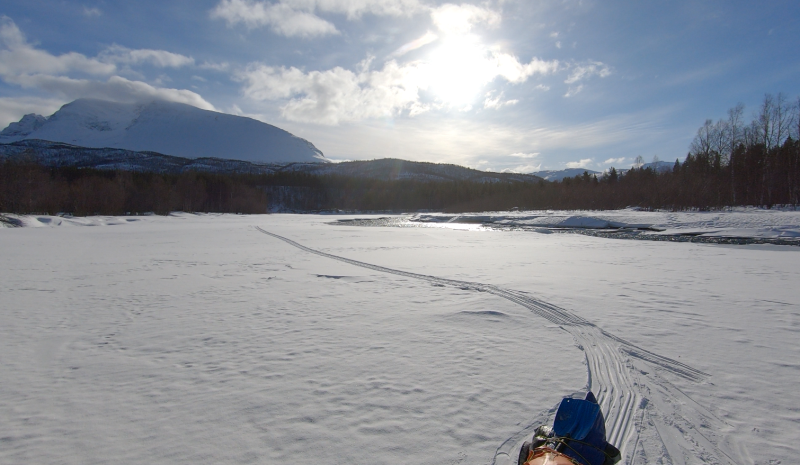
On the mostly peaceful river
A bit later tho, I started to have a few problems with some ice openings, sometimes in the middle or on the sides. At one point, the water passed over the ice, and created some sort of weird river above the river. It ended up kind of "inside" the ice, giving it a strange green color. When I poked this part, water started flowing out and I figured it would not be safe to walk on it, since I had no idea how thick the layer of ice underneath all thi was and if it was even still solid ice and not half melted. I managed to avoid it by passing through some trees after going back a little bit and getting on the side of the river.
But when this scenario occurred a second time, there wasn't much other options to cross it. Afraid the river would get worse in an upcoming narrowing where getting back on the road was impossible without coming all the way back to here, I thought it was the best option to preemptively get on the road, just in case. It was pretty hard to ascend up to there on a super slippery, iced up and steep forest road, but the actual effort on the road was mostly okay. With a bit of music to distract myself from the cars frequently passing me by at full speed, that is.
After this narrowing, the valley got wider and the river started doing a lot of laces. I did not really had much other choices than following most of them. I was slowly gaining confidence on the ice, and the openings were getting smaller. It was interesting to see how the people living here were also using the river : I met some guys with dog sleds and at some point a big vehicle was removing the snow from the ice, in order to create an "ice bridge" where the cars could take a big shortcut just by passing on the river. Pretty cool.
After a pretty tiring day packing a reasonable layer of fresh snow, and a decent uphill on a small snowy road, I was arrived at Bardufoss. Last city before arriving to the fjords!
Days 26-29 : Bardufoss - Finnsnes
I met a cool guy at the supermarket who told me about the nordic skiing tracks going from Bardufoss to Finnsnes, and the "Skisporet" app to check them out on the map and have info about their skiability (last time the machine passed over them). It saved me a ton of effort, because I was only aware of half of the trip being a ski track, and was dreading to have to trace my way through wild forest snow once more.

The nice tracks
It still wasn't exactly easy, because there was still a lot of uphill and sometimes on pretty steep slopes. But the effort was very comfortable, and I had no snow quality problems. On the way down, I had the most beautiful finish possible : A constant 10% incline road for 200m of negative elevation! Worthy of removing the skins for the first time of the trip. Going so fast with so little efforts, with a view on the fjords in the distance and after all it took me to get there, it was an amazing moment.
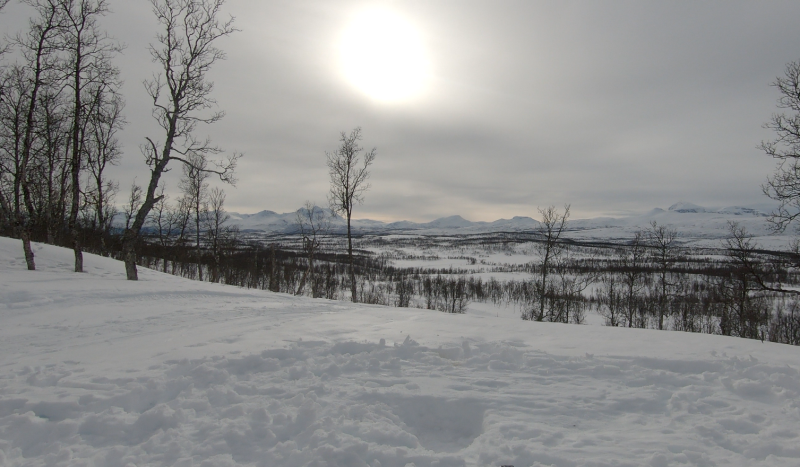
After nearly 400m of elevation gain, the reward is there!
In the evening, I got absolutely drenched by a heavy rain while setting the tent. I was glad all my pulk system, bags and clothes were fully waterproof and not just water repellent. I had to adapt a bit my processes (for example leaving my wet Gore-tex armor in the abside) but it went fine. I was also pleasantly surprised to find the lake I was on well frozen, even at such a low altitude.
After crossing it and a few more nordic skiing tracks, I arrived at the outskirts of Finnsnes. I took smaller roads in the upper residential area, because there was just too much cars on the main road. It was pretty hard to find somewhere decent to sleep that wasn't somebody's property, but in the end I managed to find a tiny piece of approximately flat snow in the middle of some trees just by the side of the road.
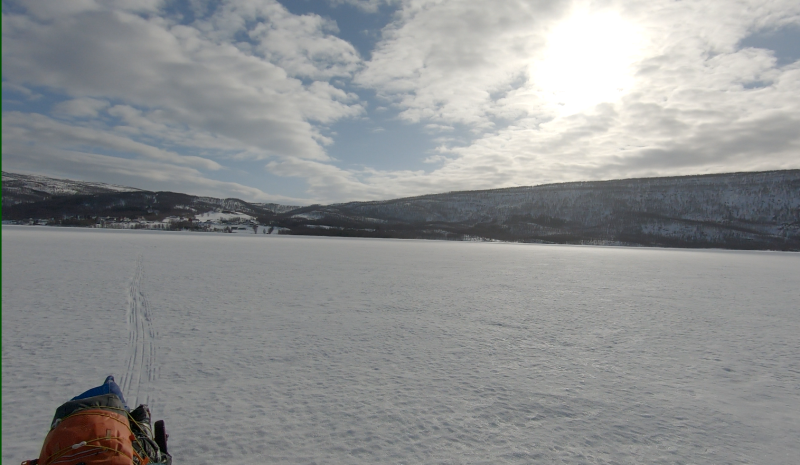
Crossing FinnfjordVatnet in the morning
At Finnsnes, I bought important stuff like shoes to walk on the road, a thicker and higher quality foam mattress, and neoprene gloves for the packrafting (and sent home stuff no longer useful, like down pants for example) Until my goal, I still had 88km of roads, 45km of skiing, and 35km of packrafting. Obviously, the packraft would be the hardest, and still was a big uncertainty.
Days 30-38 : Finnsnes - Harstad
After crossing the bridge to Senja, I enjoyed some nice nordic skiing tracks for a few kilometers. Then switched to road mode for a few more kilometers. Road mode was so much faster and comfortable with good shoes! Even tho my achilles tendons were hurting a little bit, because they weren't used to their full range of motion after a month walking only in ski boots. I then went back to the skis for a bit to pass on an epic river.
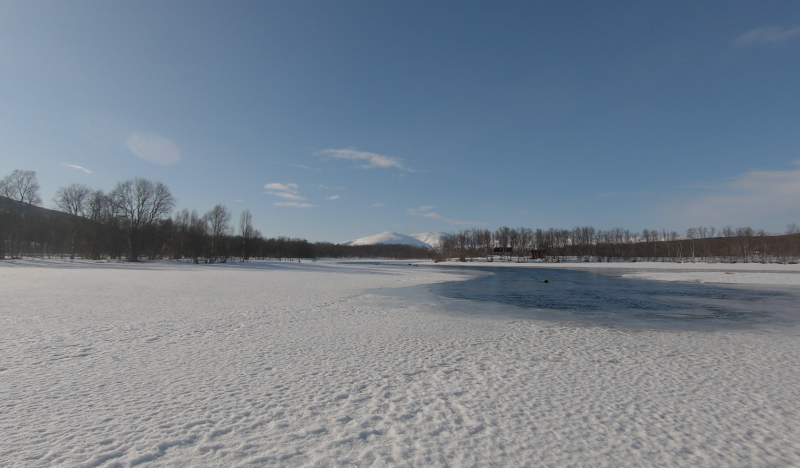
The river I bathed in
After one whole month, finally, the conditions were met : "warm", sunny and an easy to access from the sides opening in the river. Bathing time! It was so cold but also so comfortable to scrub away all the dirtiness and feel approximately clean. The rest of the river was often very smooth ice, good to slide the pulk. So I removed the skis, sat down on the pulk and just pushed with the sticks. Super speed unlocked ! The rest of the path I had drown through the wetlands went also super perfectly, because the snow was just right: hard, strong and not melting.
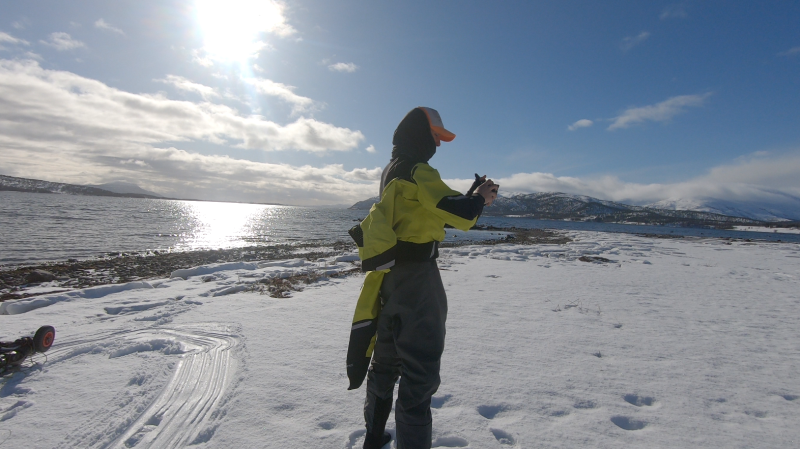
Putting on the drysuit for the first time of the trip
After a nice descent, it was time for the packrafting test. It didn't go so well, because weather conditions weren't good. I had headwind, lots of fog and even a bit of snow at some point. Moreover, I discovered a small leak in the zipper of the packraft while I was on the water, so I had to reinflate it two times from the water. My hands were freezing and my global temperature wasn't so great either, and the effort was hard. Moral was very low. But at some point I saw beautiful dolphins swimming nearby and it instantly made all the suffering worth it. Despite the headwind, I did around 5 km in around 2h, so the test was overall pretty successful.
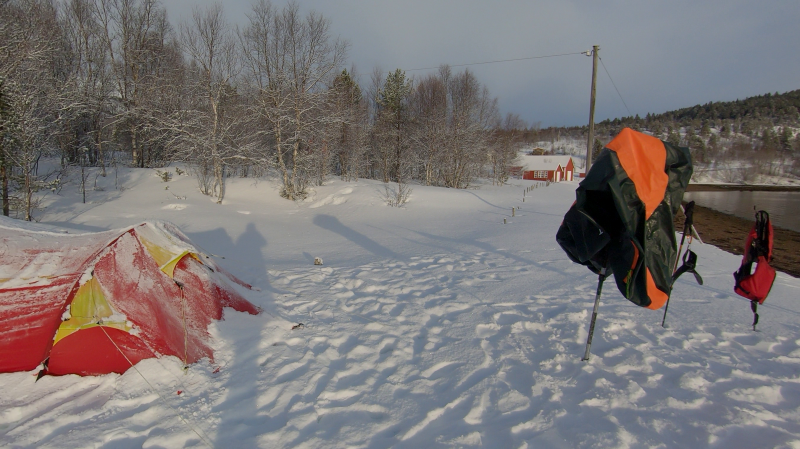
The camp after the cold and windy test
After a food and battery restock at Stonglandseidet and a very efficient bit of skiing on an iced up road, I was arrived at Skrollsvika. Across the fjord, in the distance, I could see sharp and glorious mountains, my objective for the next day. the biggest and most exposed crossing of 12 kilometers. I was pretty stressed, for good reasons, but knew that I had the capacities to do it safely. The weather forecasts predicted perfect conditions for the next day, so it was a good occasion to have a shorter walking day and enjoy bathing in the freezing sea.
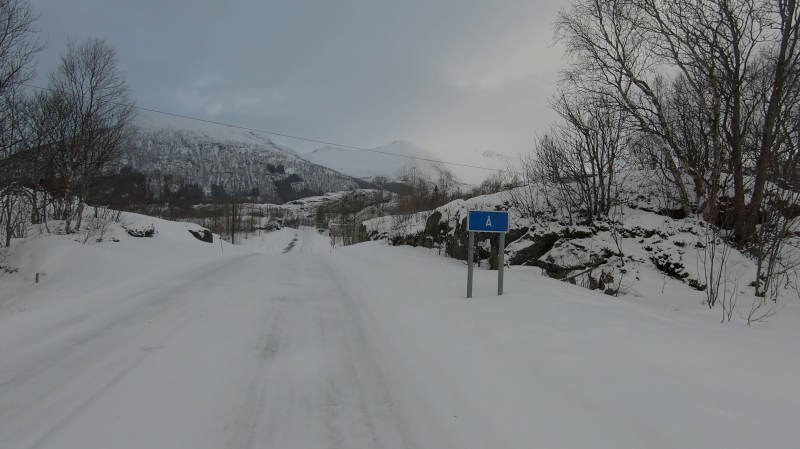
Nice snowy roads along Senja coast
Now, it was time to do it. I had done all my packing and other morning tasks meticulously and efficiently. I had put on my drysuit, neoprene socks and gloves, started the watch GPS, and the tracking on my satellite communication device. I had carried the heavy packraft and the heavy pulk down to the water while walking on all the algae uncovered by the low tide. I hopped on and started paddling out of the little creek I was in, while worrying a lot about the balance of the pulk, its stability on the waves, the little bit of sideways wind and if we were actively being pushed by it or not.
Paddle stroke after paddle stroke, my sights fixed on the mountains on the horizon, I slowly processed that everything was going smoothly and that there were no particular problems. The pressure and stress slowly faded out and left room for pure excitement and joy as I realized that I was actually doing it. Assisted by the GPS and my paper map, I could tell I was progressing smoothly and almost on the perfect trajectory. I admired the beautiful landscape and sang to epic songs like "Never gonna give you up" for a few hours until I was finally arrived on the other side, on an idyllic sandy beach. I was so proud of myself after this crossing, especially because of all the solution finding, gear crafting and investments that I had to do to turn a seemingly unreasonable project into a safe and doable crossing. The northern lights above the sea and the summits I saw during this evening were particularly beautiful.
On the next day, I only walked on roads. It was pretty efficient, the weather was great and I was feeling good. I averaged around 4 kilometers per hour instead of the usual 2.5 or 3 on the snow. I was rewarded with another super nice hypothermia inducing bath in the sea at the sunset, it was pretty cool.
It was already time for the second crossing, measuring 3 and a half kilometers. I had the idea to keep paddling up to Harstad, but the weather turned pretty bad when I was in the middle. The wind started blowing against me, and soon enough, created a surface current pushing me sideways. After a few minutes fighting for a pretty ridiculous 2km/h, I bailed and went for the shortest crossing. It went pretty well, even tho doing all the packing with the gear still wet and my hands still painfully cold wasn't easy.
Days 39 - 45: Harstad - Myre
After buying food, I still did a pretty neat ascent on a nice road before going to sleep near the parking at the start of the nordic skiing tracks. On the next day, I noticed my skins were just a piece of sticky fabric in the middle spot, not sliding very much on the snow and probably slowing me down. So I tried to fix it by doing some sort of ski skin surgery, gluing a piece of the intact parts to the middle of the ski. I took way too much time and in the end I just switched problems because now it was slipping too much lol. But there wasn't too much skiing left to be done anyway.
After a good night's rest, I had a long, rewarding but also freezing cold crossing of 9 kilometers. The watering was pretty hard because I had to carry all my stuff on uneven and slippery rocks. The view from the water was absolutely breathtaking, and the only real problem was my hands, pretty painful because of the cold.
Then, I did the two last days of skiing. It started off with an epic 200m uphill in wild snow, maybe 20 cm of powder or so. In addition with packing the bushes underneath, it was enough to make the effort really hardcore. But as always, the views were epic and we knew it was kind of the last time we would have those full snow pulk pulling days.
It was now time for the final obstacles : the two last crossings. There wasn't any perfect conditions days in the forecast, but I had two reasonably nice days. The first crossing wasn't a problem, but the final one was pretty exposed to waves, currents, and to the open ocean. I wasn't sure whether or not I would be able to do both in one day or if I would have to split this last "weather depending part" in two days.
Just in case, I started the day early and got the first crossing done efficiently. Conditions were perfect, everything went well. Then, there was 8 kilometers of road that also got done surprisingly fast. Seeing the doable conditions of the last fjord and my ok-tier physical shape, I decided to go for it. To adapt to the drift current going up north, I started a bit more south than I had planned, giving myself more room for maneuvering and almost removing the risk of missing the targeted island.
But right as I was inflating my packraft, the zipper opened back up! I started panicking in my head imagining that this zipper I have to trust my life to could maybe open again while on the water. It pains me a lot to consider potentially giving up so close to the finish line. But as I take the time to clean the zip from the sand that caused the problem, I realize that it still works approximately. I reinforce it with Aquasure glue to seal the zip itself and the cracks in the material around it. I take into account that since I have a satellite communicator, a drysuit and help nearby (ports, towns and stuff just across the fjord), the very unlikely case of packraft failure would very likely not mean immediate death. Those two factors combined reduced the real risk to a tiny tiny number that for me was acceptable, so the answer to the "go/nogo" question was "go". But I have to admit with the big waves and this additional risk I wasn't feeling very comfortable.
I started by paddling frantically and way too fast because I let the stress of the situation get to my head. A few minutes in I was able to calm down, still push reasonably strong but more efficiently. The pulka was managing those bigger waves very well, and thanks to my trajectory correction, I did not have to fight the current too much. After maybe one hour, I reached the islands marking the start of a more protected area, where the risk of drifting off further than planned was minimal. After checking the maps, I noticed I was able to change direction and go up to the original destination with the wind in my back. The waves chilled out, the sun was setting, it was a pretty beautiful scenery. I was almost arrived, it almost felt too easy, surreal. I chilled out a few minutes before reminding myself that it would only really be done once landed safely on the beach.
Only a few other minutes later, I was approaching a nice spot, still not really believing it. I reached to check the depth with my paddle, and when I felt it bounce against the sea floor at 60cm it finally hit me : I had done it. All the stress, fear, and pressure disappeared and left only pure excitation, joy and happiness. The relief was pretty crazy. I kind of celebrated the success of the whole adventure in this exact instant, since I knew there were no more real obstacles on my way to Nyksund.
I then spent a whole day drying all my packrafting gear and resting, because else I would arrive at Myre for the sunday and face closed doors at the supermarket. It made me notice that my body was actually pretty hurt and tired overall, especially achilles tendons. I was glad to keep going and reach Myre peacefully by the roads, leaving this problem for after the end of the trip.
Days 46-47 : Nyksund
After recharging all my gear, shopping for a bit of food and having nice encounters with people (like for example this cool journalist from a local journal who made an article about me lol), I was on my way. The road quickly became pretty gravelly and a bit harder to haul the pulk on, but it was to be expected since Nyksund is tiny tweeny hamlet. I also met people telling me more about the interesting history of this place. In the big lines, it was originally a fishermen settlments reachable only by boat. around 1950 they built a road but 10 years later everyone had to evacuate because of some theoretical landslide danger. It stayed a ghost town for a while despite a few projects to make a touristic destination of it, before around 1990 the locals started going back and repairing their old houses. Now it sees a decent amount of tourists in the right seasons, people live there again, it's a pretty cool place!
After only one night above the sea and a few hours on this road, I was finally arrived. I installed the tent before taking my tripod, a ski and a paddle to take victory pictures at the precise end of the 69th parallel. Or more like the western end of the European part of the 69th parallel. Pretty specific x). It felt a bit anticlimatic since there is nothing but a bunch of rocks there, but seeing the compass finally pointing to the endless sea was pretty satisfying.



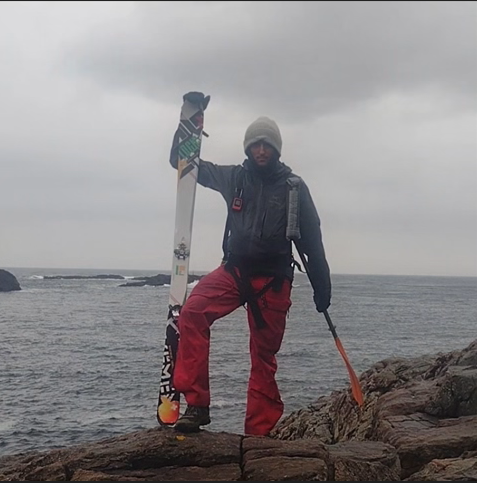
 MY YOUTUBE
MY YOUTUBE
 MY INSTAGRAM
MY INSTAGRAM